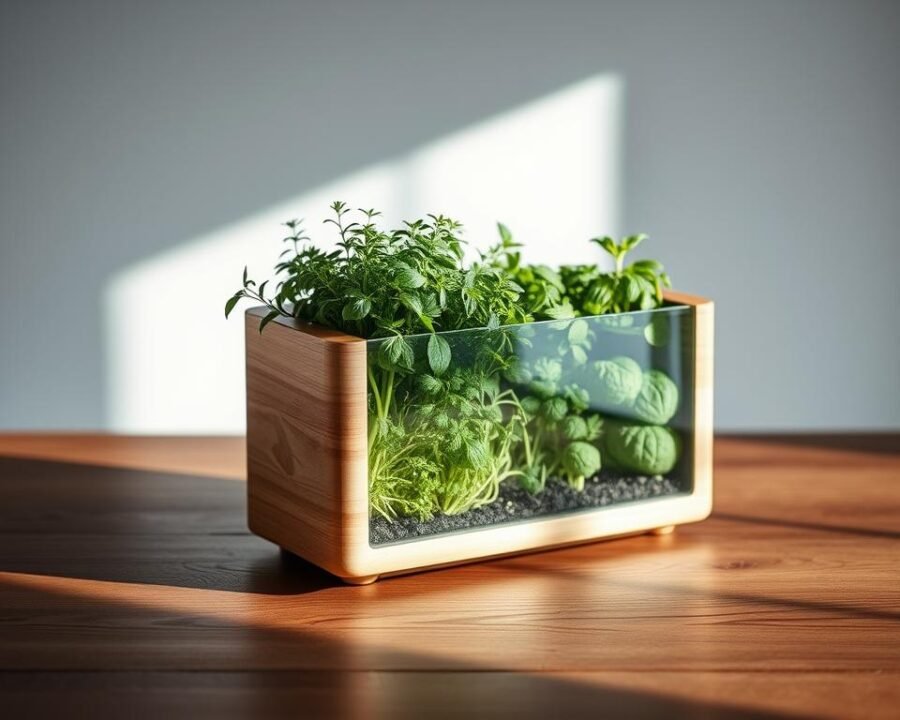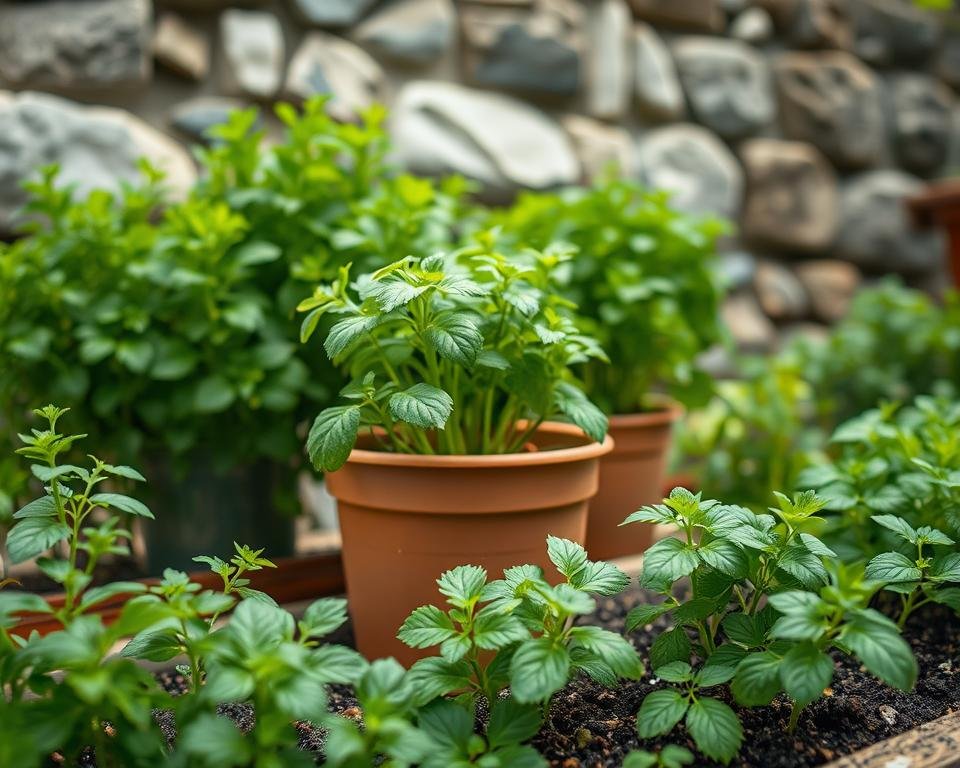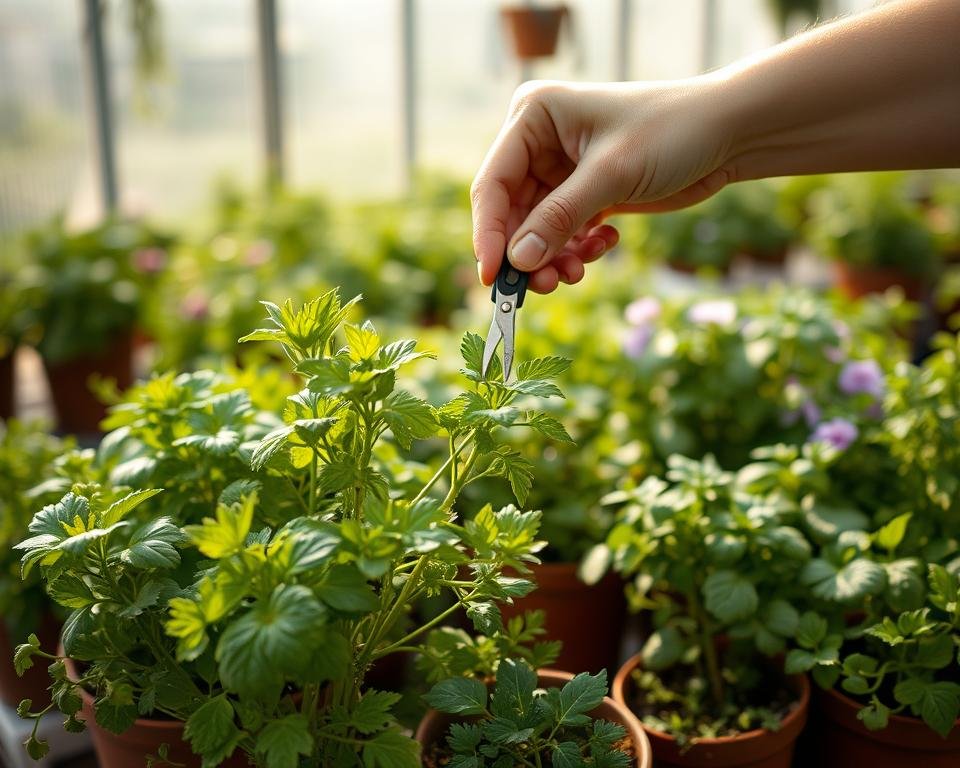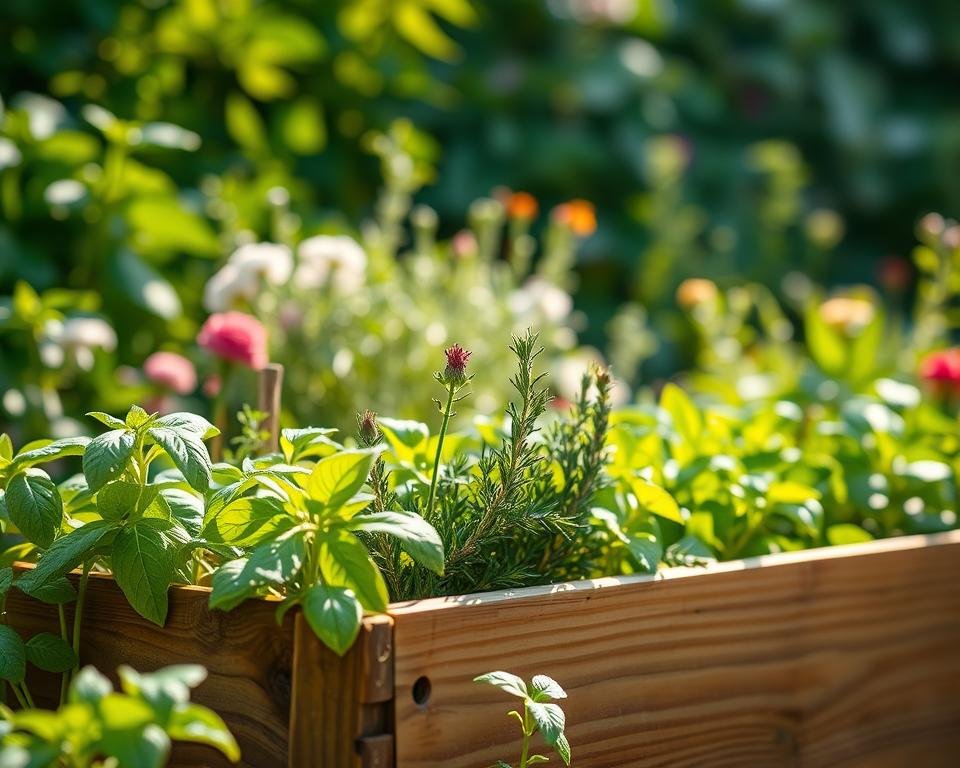There’s something magical about snipping fresh basil for pasta or garnishing a dish with homegrown rosemary. The aroma, the taste, and the pride of nurturing your own greens—it’s a joy many are discovering. Whether you’re a seasoned gardener or just starting your first herb garden, we’re here to make it simple.
More people are turning to homegrown herbs for their kitchens. No more wilted store-bought bundles—just vibrant, flavorful leaves ready when you are. Our guide cuts through the confusion, helping you avoid common pitfalls like poor soil choices or overcrowded pots.
From selection to care, we’ll walk you through each step. Imagine plucking thyme for roasted veggies or mint for summer drinks—all from your windowsill or backyard. Let’s dive in!
Key Takeaways
- Home herb gardening is trending for its freshness and convenience.
- Beginners and experts alike can succeed with the right guidance.
- Avoid mistakes like improper spacing or low-quality seeds.
- Popular varieties like basil and rosemary are easy to nurture.
- Our guide covers everything from planting to harvest.
Why Growing Your Own Herbs Is Worth It
Store-bought herbs pale in comparison to the vibrant taste of those nurtured in your own space. Supermarket varieties often travel long distances, losing flavor and nutrients along the way. With a kitchen garden, you’ll enjoy peak freshness—right from soil to plate.
Flavor That Packs a Punch
Homegrown fresh herbs deliver bold, nuanced flavors. Studies show basil loses 50% of its essential oils within 24 hours of harvest. Compare that to snipping leaves moments before cooking—it’s a game-changer.
| Herb | Store-Bought Flavor | Homegrown Flavor |
|---|---|---|
| Basil | Mild, slightly bitter | Sweet, peppery, aromatic |
| Rosemary | Woody, dull | Pine-like, resinous |
| Cilantro | Earthy, muted | Bright, citrusy |
More Than Just Taste
Beyond flavor, grow fresh herbs to unlock health perks. Freshly picked varieties contain higher phytonutrients. These compounds support immunity and reduce inflammation.
“Gardening with herbs reduces stress and connects us to nature’s rhythms—a bonus for mental well-being.”
Herbs also save money. A $3 supermarket pack lasts one meal, while a single plant yields months of harvests. Plus, tending to them herbs feel like a rewarding daily ritual.
How to Grow Herbs to Plant Everyone Is Using
Chefs and home cooks alike treasure herbs grown just steps from their kitchens. Selecting the right varieties ensures a steady supply of vibrant flavors. Let’s explore six standout options that thrive with minimal effort.
Must-Have Herbs for Every Kitchen
Basil loves warmth and well-drained soil. Its sweet, peppery leaves pair perfectly with tomatoes—both in dishes and as companion plants. Try lemon basil for a citrusy twist.
Rosemary thrives in sunny spots with little water. Its pine-like aroma elevates roasted meats and bread. For small spaces, opt for upright varieties like ‘Blue Spire’.
- Thyme: Drought-tolerant and perfect for seasoning soups. Creeping types work well in rock gardens.
- Cilantro: Grows fast but bolts in heat. Sow seeds every 3 weeks for continuous harvests.
- Parsley: Biennial and nutrient-rich. Flat-leaf types pack more flavor than curly.
Smart Planting Tips
Mint spreads aggressively—always plant it in containers to avoid overtaking your *herb garden*. Herbs like basil and parsley yield repeated harvests when trimmed properly.
“Purple sage and Thai basil are secret weapons in professional kitchens. They’re just as easy for home gardeners to cultivate.”
Pair basil with tomatoes to deter pests naturally. For *herbs directly ground*, ensure proper spacing to prevent overcrowding. With these picks, your meals will burst with garden-fresh taste.
Where to Source Your Herb Plants or Seeds
Not all herb sources are created equal; smart selection impacts your garden’s success. Whether you’re at a head plant store or browsing online, quality matters. Let’s uncover the best places to learn first buy strategies that ensure thriving plants.
Why Big-Box Stores Might Disappoint
Chain retailers often treat plants with synthetic chemicals to prolong shelf life. These treatments can stunt growth or harm pollinators. Transport stress also weakens plants before they even reach your shop herb container.
Ask nursery staff:
- “Are these plants grown without neonicotinoids?”
- “How long have they been in transit?”
Local Nurseries vs. Seed Suppliers
Local nurseries offer healthier starts adapted to your climate. Seed suppliers like Baker Creek or Botanical Interests provide non-GMO options with higher germination rates. Compare:
| Source | Pros | Cons |
|---|---|---|
| Nurseries | Instant plants, local advice | Limited varieties |
| Seed Suppliers | Wider selection, organic options | Longer wait time |
“Always check for the USDA Organic seal or Non-GMO Project verification—your first buy last decision affects your garden’s future.”
For seeds, prioritize brands with 85%+ germination rates. Your shop herb container will thank you!
Choosing the Right Herbs for Your Space
Transform any corner of your home into a lush, aromatic retreat with the right herb choices. Whether you’re working with a sunny windowsill or a shaded balcony, matching plants to their ideal environment ensures a success herb garden.
Indoor vs. Outdoor Thrivers
Not all herbs adapt equally to indoor life. Basil and parsley flourish near sunny windows, while rosemary and thyme prefer outdoor breezes. Consider sunlight needs before placing them:
| Herb | Indoor Light | Outdoor Light |
|---|---|---|
| Basil | 6+ hours direct | Full sun |
| Mint | 4-6 hours indirect | Partial shade |
| Oregano | Bright, indirect | Full sun |
Beginner-Friendly Picks
New gardeners ‘ve found success with hardy varieties like chives and oregano. These tolerate irregular watering and still deliver robust flavors. Avoid fussy herbs like cilantro until you’re confident.
- Chives: Grow in pots or ground; snip leaves as needed.
- Oregano: Thrives in poor soil—perfect for forgetful waterers.
- Thyme: Drought-resistant and versatile in recipes.
Watch out for invasive plant family herb species like mint. Plant them in containers to prevent garden takeovers. For apartments, try vertical planters or hanging baskets to maximize space.
Microclimates matter too. Coastal areas suit lavender, while humid regions favor basil. Observe your local conditions to match herbs naturally.
Essential Tools for Starting Your Herb Garden
Quality gear makes all the difference when nurturing aromatic greens. With the right supplies, you’ll avoid common pitfalls and enjoy lush growth. Let’s explore the tools that deliver results.
Must-Have Supplies for Success
A Hori Hori knife is a gardener’s multitasker—perfect for digging, cutting, and even measuring soil depth. Pair it with pH test strips to monitor acidity. Herbs like basil thrive at 6.0–7.5 pH.
For precise watering, choose a can with a narrow spout. Overhead sprays can damage delicate leaves. Ergonomic weeders save wrists, while steel safely grow gloves shield hands from thorns and irritants.
Budget-Friendly Alternatives
Skip pricey propagation stations. Use egg cartons or yogurt cups with drainage holes for seedlings. Old spoons work as mini trowels, and chopsticks make ideal dibbers for planting seeds.
| Tool | Premium Option | Budget Swap |
|---|---|---|
| Propagator | Heated mat ($40) | Plastic dome ($5) |
| Pruners | Titanium-coated ($25) | Floral scissors ($8) |
| Right gardenary container | Food-grade galvanized stainless | Recycled tin cans |
“Invest in one quality tool each season. Over time, you’ll build a kit that lasts decades.”
Multi-use items like mason jars double as herb dryers. Bamboo skewers label plants and aerate soil. With these smart picks, your garden stays thriving—without breaking the bank.
Selecting the Perfect Container for Your Herbs
The right container can make or break your herb garden’s success. A well-designed herb container balances aesthetics with functionality, ensuring roots stay healthy and plants thrive. Let’s explore what makes a container ideal.

Why Drainage Is Critical
Without proper drainage, roots suffocate and rot. Saladdrainage holes avoid waterlogged soil—a common killer of basil and mint. Aim for holes at least 1/4-inch wide, spaced evenly across the base.
Terra cotta pots excel at wicking moisture away, while plastic retains water longer. Metal containers, like galvanized stainless steel, need extra holes to compensate for slower evaporation.
Materials Matter
Food-grade galvanized stainless resists rust and won’t leach chemicals into soil. It’s lightweight yet durable, though it heats up in direct sun. Terra cotta breathes well but dries out fast—perfect for drought-tolerant thyme.
- Plastic: Affordable and lightweight, but prone to cracking over time.
- Ceramic: Stylish but heavy; ensure it has drainage holes.
- Fabric pots: Promote air pruning but require frequent watering.
“Metal containers need a layer of gravel underneath to improve drainage and insulate roots from temperature swings.”
For decorative pots without holes, add a 2-inch layer of pebbles before soil. This creates a reservoir to avoid soggy roots while keeping your setup visually appealing.
Creating the Ideal Soil Mix for Your Herbs
Healthy soil is the foundation of a thriving herb garden. The right blend ensures strong roots, vibrant growth, and rich flavors. Let’s craft the perfect home for your plants.
The Perfect Blend: Topsoil, Compost, and Sand
Mediterranean herbs like rosemary and thyme need well-draining soil. A balanced 1:1:1 mix of topsoil, compost, and construction-grade sand works wonders. This combo prevents waterlogging while providing nutrients.
Construction sand has coarse grains that improve drainage. Beach sand contains salt and fine particles that compact over time. Always opt for paver or horticultural sand.
| Soil Component | Purpose | Best Type |
|---|---|---|
| Topsoil | Base structure | Screened, organic |
| Compost | Nutrients | Leaf mold or worm castings |
| Sand | Drainage | Coarse construction grade |
Testing Your Soil’s Drainage
The squeeze test reveals if your mix drains properly. Grab a handful of moist soil and press it firmly. If it holds shape but crumbles when touched, it’s ideal. If it stays compacted, add more sand.
pH levels matter too. Most herbs prefer slightly acidic to neutral soil (6.0–7.0). Use a simple test kit to check. For alkaline-loving plants like oregano, add crushed eggshells.
“Earthworm castings are nature’s slow-release fertilizer. A thin layer on top boosts growth without burning delicate roots.”
For herbs right gardenary success, refresh soil annually. Top-dress with compost every season to maintain fertility. Your plants will reward you with lush, aromatic leaves.
- Salad greenswater tray tip: Place pebbles under pots to improve airflow.
- Rotate herbs yearly to prevent soil depletion.
- Add perlite for extra drainage in humid climates.
Step-by-Step Guide to Planting Your Herbs
Getting your hands dirty is the best part of starting a special space for fresh flavors. With the right approach, even beginners can achieve lush growth. Follow these steps to set up your plants for success.
Prepping Your Container
Begin with a clean container that has proper saladdrainage holes. Line the bottom with a coffee filter or mesh to prevent soil loss. Fill it halfway with a well-draining mix—combine potting soil with perlite for best results.
For Mediterranean varieties like rosemary, add extra sand. Moisture-loving mint thrives with a bit of compost mixed in. Always leave an inch of space below the rim for easy watering.
Planting Seeds vs. Seedlings
Seeds offer variety but need patience. Sow them at the right depth:
- Basil: ¼ inch deep, spaced 2 inches apart
- Parsley: ½ inch deep, as it germinates slowly
- Chives: Surface-sown, lightly covered
For seedlings, gently loosen the root ball before planting. Bury stems up to the first set of leaves—this encourages stronger roots. Water lightly to settle the soil.
“Harden off store-bought seedlings by placing them outside for a few hours daily. Increase exposure over a week to prevent shock.”
Space plants according to their mature size. Basil needs 8–12 inches, while thyme spreads well at 6-inch intervals. Companion planting? Pair basil with tomatoes, but keep dill away from carrots.
Watering Your Herbs the Right Way
Watering seems simple, yet it’s the #1 reason herbs thrive or fail. Too much drowns roots; too little stunts growth. We’ll help you master the balance for lush, flavorful plants.

The Finger Test vs. Moisture Meters
Skip guesswork. Press a finger 1–2 inches into the soil—if it’s dry, water; if damp, wait. Moisture meters offer precision but aren’t essential. Mediterranean herbs like rosemary prefer drier soil than basil.
Spotting Water Stress
Leaves tell all. Yellow, droopy foliage often signals over-watering herbs salad. Crispy brown edges? Underwatered. Adjust weekly based on weather—herbs drink more in summer heat.
- Bottom-watering: Place pots in a tray to water avoid messy foliage and encourage deep roots.
- Seasonal shifts: Reduce frequency in winter when growth slows.
- Recovery: For waterlogged plants, repot in fresh soil and trim rotten roots.
“Herbs in clay pots dry faster than plastic. Match your watering routine to the container.”
Morning watering reduces evaporation. Avoid wetting leaves at night to prevent mold. With these tweaks, your herbs will stay perfectly quenched.
Providing the Right Light for Growth
Light fuels the magic behind every thriving herb garden. Without proper exposure, even the most carefully tended plants struggle to reach their full potential. We’ll guide you through optimizing light conditions for robust growth and vibrant flavors.
Sunlight Needs by Herb Variety
Most culinary favorites crave 6–8 hours of direct sunlight daily. Mediterranean natives like rosemary and oregano thrive in full sun, while mint and parsley tolerate partial shade. Here’s a quick reference:
| Herb | Daily Sunlight | Light Type |
|---|---|---|
| Basil | 6–8 hours | Direct |
| Thyme | 6+ hours | Direct |
| Chives | 4–6 hours | Direct/Partial |
South-facing windows work best indoors. Rotate pots weekly to prevent lopsided growth. For fresh herbs right on your countertop, consider compact varieties like ‘Spicy Globe’ basil.
Creative Solutions for Dim Spaces
Not all homes flood with sunlight—but that shouldn’t stop you. Reflective surfaces like aluminum foil or white boards amplify existing light. Position them strategically to bounce rays onto your plants.
Grow lights offer precision control:
- LEDs: Energy-efficient with adjustable spectrums (14–16 hours daily)
- Fluorescents: Affordable but less intense (keep 4–6 inches above plants)
“Parsley and lemon balm adapt well to low-light conditions. Pair them with a simple LED setup for year-round harvests.”
For spaces with minimal natural light, try these resilient options:
- Curly parsley (3–4 hours sunlight)
- Garlic chives (bright indirect light)
- Vietnamese coriander (shade-tolerant)
With these adjustments, your garden will flourish regardless of lighting challenges. Herbs feel like natural companions when given what they need to thrive.
Feeding Your Herbs for Optimal Health
Nutrients are the silent heroes behind every thriving herb garden. While sunlight and water get the spotlight, proper feeding unlocks robust growth and intense flavors. Let’s explore how to nourish your plants naturally.
Earth’s Best Buffet: Natural Fertilizers
Compost tea is a gentle, fast-acting option. Steep compost in water for 48 hours, then strain. It delivers microbes that boost soil health. For granular options, try worm castings—packed with nutrients and perfect for herbs right gardenary setups.
Compare popular choices:
| Fertilizer | NPK Ratio | Best For |
|---|---|---|
| Fish emulsion | 5-1-1 | Leafy herbs (basil, parsley) |
| Kelp meal | 1-0-4 | Stress recovery |
| Bone meal | 3-15-0 | Root development |
Timing Is Everything
Most herbs need feeding every 4–6 weeks during active growth. Slow-growing varieties like rosemary thrive with half-strength doses. Always water soil before applying fertilizers to prevent root burn.
Spot deficiencies early:
- Yellow leaves: Often nitrogen deficiency—try compost tea.
- Purple stems: Phosphorus shortage—bone meal helps.
- Weak growth: Potassium needed—add wood ash sparingly.
“Foliar sprays with diluted seaweed extract work wonders for stressed plants. Apply early morning to avoid leaf burn.”
Over-fertilization harms more than neglect. Signs include crusty soil salt deposits or curled leaf tips. If this happens, flush soil with water and skip feeding for 8 weeks. Steel safely grow gloves protect hands when handling amendments.
Pruning and Harvesting Your Herbs
Strategic cuts transform sparse plants into lush, productive bushes. A well-maintained success herb garden rewards you with fresh flavors all season. Let’s explore how to prune and harvest for maximum yield.

When and How to Prune
Start pruning when plants reach 6–8 inches tall. Always cut just above a leaf node—this encourages branching. For basil, pinch off the top set of leaves to prevent flowering and boost leaf production.
Morning is ideal for harvesting. Oils peak at dawn, delivering intense flavor. Use sharp scissors to avoid crushing stems. The cut-and-come-again method works wonders: snip outer leaves, leaving the center to regrow.
Tips for Continuous Growth
Gardeners who’ve found success swear by these tricks:
- Rotate harvests: Take 1/3 of the plant at a time to avoid stress.
- Deadhead flowers: Redirect energy to leaves by removing buds.
- Preserve excess: Dry or freeze herbs in olive oil for later use.
“Prune herbs like mint weekly to prevent leggy growth. A little effort keeps plants compact and flavorful.”
For woody herbs like rosemary, trim stems back to green growth. Avoid cutting into old wood—it may not regrow. With these techniques, your garden stays productive and vibrant.
Troubleshooting Common Herb Garden Problems
Even the most carefully tended herb gardens face challenges—here’s how to spot and solve them. Early action prevents small issues from becoming big headaches. We’ll cover organic fixes for pests, diseases, and nutrient gaps.
Spotting Pests and Deficiencies
Aphids cluster on new growth, leaving sticky residue. Spider mites create fine webs under leaves. Yellowing often points to overwatering or nitrogen shortage. Check plants weekly for early signs.
| Problem | Symptoms | Quick Fix |
|---|---|---|
| Aphids | Curled leaves, sticky honeydew | Blast with water or apply neem oil (2 tbsp/gal) |
| Spider Mites | Tiny webs, speckled leaves | Wipe with soapy water (1 tsp dish soap/qt) |
| Magnesium Deficiency | Yellow between leaf veins | Epsom salt spray (1 tbsp/qt water) |
Organic Solutions That Work
Companion planting deters pests naturally. Basil repels thrips near roses, while marigolds ward off nematodes. For excess water avoid root rot, add perlite to soil or use a tray collect excess drainage.
- DIY sticky traps: Coat yellow cards with petroleum jelly to catch whiteflies.
- Garlic spray: Blend 2 cloves with water; strain and spray to deter beetles.
- Oregano tea: Steep dried leaves in water for antifungal properties.
“Rotate herbs yearly to disrupt pest cycles. Many insects overwinter in soil—breaking their habitat reduces infestations.”
For avoid messy overflowmeasures, elevate pots with pebbles. This improves airflow and prevents soggy roots. Healthy plants resist pests better—focus on balanced light, water, and nutrients first.
Creative Ways to Use Your Homegrown Herbs
Your homegrown harvest unlocks endless culinary creativity beyond basic seasoning. Whether you’re crafting meals, drinks, or DIY projects, fresh herbs add vibrant flavors and aromas. Let’s explore their full potential.
From Kitchen to Glass
Elevate dishes with herb-infused oils or butters. Blend basil into pesto, or sprinkle thyme over roasted veggies. For drinks, muddle mint in lemonade or steep lavender in hot tea.
Try this refreshing herbs salad greenswater booster:
- Combine cucumber slices, lemon balm, and mint in a pitcher.
- Add ice and filtered water.
- Let sit for 1 hour—perfect for summer hydration.
Preserving Your Bounty
Freeze chopped herbs in ice cube trays with olive oil—ideal for quick sautéing. For drying, bundle stems and hang them in a dark, airy space. Store dried leaves in airtight jars.
“Herb-infused vinegars capture summer flavors year-round. Try tarragon in white wine vinegar for salad dressings.”
For cocktails, rosemary sprigs add earthy notes to gin tonics. Edible flower arrangements with sage blooms impress guests. With these ideas, your garden’s impact stretches far beyond the soil.
Expanding Your Herb Garden
Taking your herb garden to the next level opens exciting possibilities for flavor and variety. Whether propagating favorites or introducing new plants, these techniques maximize your green space’s potential.
Multiplying Your Favorites
Stem cuttings offer the simplest propagation method. Snip 4-6 inch stems just below a node, then remove lower leaves. Rooting hormone boosts success rates to 80%, while water propagation works well for mint and basil (60% success).
For mature plant family herb clusters like chives, division works wonders. Gently separate roots in early spring, ensuring each section has healthy growth points. This rejuvenates older plants while creating new starters.
Introducing New Varieties
Seasonal rotation keeps your garden productive year-round. Cool-weather lovers like chervil replace heat-sensitive basil in fall. When planting herbs directly ground, mark spaces to avoid disturbing perennial roots.
Explore these unique flavors:
- Pineapple sage: Tropical-fruity leaves for teas and desserts
- Lemon thyme: Citrusy twist for poultry and fish
- Garlic chives: Flat leaves with mild garlic punch
“Saving seeds from heirloom varieties preserves genetic diversity. Store dried seeds in labeled jars with silica packets to maintain viability.”
For continuous harvests, stagger planting every 2-3 weeks. Track growth habits to prevent aggressive spreaders from dominating. With these strategies, your garden evolves into a personalized flavor laboratory.
Conclusion
Fresh flavors from your windowsill transform everyday meals into something special. A small herb garden delivers convenience, savings, and vibrant tastes—no backyard required. Start with one pot of basil or thyme, then expand as confidence grows.
Remember: quality soil and proper containers set the stage for success. Local nurseries offer the best starts, while DIY mixes ensure drainage. Have questions? Share them below—we love helping green thumbs thrive.
Ready for more? Explore advanced pruning techniques or companion planting guides. Whether you grow herbs indoors or out, each leaf brings your kitchen closer to nature’s bounty.
